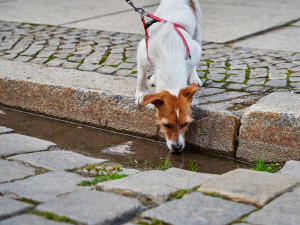Mange in Dogs: Causes, Symptoms, and Treatment for the Canine Skin Condition
Cool, cool, cool (heavy sarcasm here). These are some steps you can take.

Share Article
In This Article:
What Is Mange? What Causes Mange? Symptoms of Mange In Dogs How Do Veterinarians Diagnose Mange? How Is Mange Treated? Frequently Asked Questions
OK, don’t freak out, but here are a couple of questions: Has your puppy’s coat started to thin around the eyes? Does your older dog’s skin suddenly look a little like Deadpool’s? If your answer is yes, your dog might have mange.
Luckily, mange can be treated, so read on to learn more about the condition. Mange is usually easy to treat.
What is mange?
Mange is one of the most common skin issues dogs face. Although most people have heard the term “mangy” to describe a shabby-looking coat (maybe just in the movie Annie, but still), many don’t relate it to an actual disease. Mange is, however, a skin disease triggered by microscopic, parasitic mites.

Mange can either be localized or generalized. Localized mange occurs primarily on the face, especially around the eyes. It can also show up in other areas and still be considered localized as long as it is limited to a couple of spots in one area. Generalized mange either encompasses larger patches, involves multiple areas of the body, persists for more than six months, or affects the feet.
Types of mange in dogs
There are two primary types of mange in dogs: demodectic and sarcoptic. Important differences between the types of mange affect treatment, prognosis, and spread.
The Demodex mite causes demodectic mange. These mites live in a dog’s hair follicles and are normally passed from mother to pup early in life. They are an expected resident of a dog’s skin but usually occur in small numbers. When a dog’s immune system isn’t working as it should, these mites can grow rapidly in number and begin to cause issues.
Demodectic mange comes in two varieties: juvenile-onset and adult-onset. Juvenile-onset mange is usually localized and mild, though some dogs are unlucky and develop generalized mange. This generalized version occurs more commonly in American Staffordshire Terriers, other Pit Bull-type dogs, English and French Bulldogs, Chinese Shar Pei, and Boxers.
Adult-onset mange is usually associated with something suppressing the immune system, like hypothyroidism, Cushing’s disease, diabetes, steroid administration, or chemotherapy.
Sarcoptic mange (also called scabies) is caused by mites that are not a normal part of a dog’s skin population. They usually live on the skin's surface, but female mites will tunnel into it to lay eggs. Even a few of these mites will cause severe irritation because dogs react strongly to the mite’s outer shell, eggs, and feces.
What causes mange?
An overgrowth of parasitic mites causes mange in dogs. These mites can overcome the skin’s natural defenses if a dog’s immune system is compromised due to genetics, drugs, or disease. Once the normal skin barriers are broken, mange mite infestation can also lead to secondary bacterial infection.
Symptoms of mange in dogs
Mange can show up in a few different ways, depending on the type of mite and the dog’s immune system. Most mild cases of juvenile-onset demodectic mange involve a couple of small, thin-haired spots with a crusty appearance to the skin around the eyes, face, or legs. Generalized demodectic mange lesions may be larger and more severe.
Sarcoptic mange tends to show up along the margins of the ears, elbows, lower chest, and outside of a dog’s ankles. It is a zoonotic condition, which means that humans can get it from their pups. General signs of mange can include:
Hair loss
Skin lesions (crusts, scales, pimples)
Redness
Swelling
Itching (more common in sarcoptic mange)
Hyperpigmentation (darkening of the skin)
How do veterinarians diagnose mange in dogs?
Veterinarians diagnose mange in dogs using a combination of clinical signs, diagnostic tests, and history-taking. Here’s a breakdown of the diagnostic process:
Physical examination: The vet looks for signs of hair loss, redness, thickened skin, scabbing, and intense itching. The location and pattern of hair loss can help differentiate between sarcoptic mange (ears, elbows, abdomen) and demodectic mange (localized patches or generalized over the body).
Skin-scraping: A deep skin-scraping is just what it sounds like. An area of the skin is scraped with a blade and is examined under a microscope to identify mites. Demodex mites (Demodectic mange) live in hair follicles. Sarcoptes mites (Sarcoptic mange) are harder to detect, so multiple scrapings may be needed.
Trichogram (hair pluck test): The vet may pluck hairs and examine them under a microscope for Demodex mites.
Tape impression or acetate tape test: This method is less about finding mites than identifying secondary bacterial or yeast infections.
Fecal examination: Dogs with sarcoptic mange may ingest mites, and fecal flotation tests can sometimes reveal the mites.
Response to treatment (therapeutic trial): If mites are not found but mange is strongly suspected, the vet may prescribe anti-parasitic treatment (e.g., ivermectin, isoxazolines) and observe if symptoms improve.
Skin biopsy: A biopsy may be taken to confirm mange or rule out other skin conditions, but this is rarely needed.
How is mange treated?
Mange is treated very differently than most other skin diseases in dogs. The type of mange will help to determine the treatment. Many puppies with a mild case of mange may not need any treatment at all. Because most localized bouts of juvenile demodicosis resolve quickly, treatment isn’t necessary for most puppies. Dogs with generalized demodectic mange or sarcoptic mange will need treatment, though.
Medications for mange
Mange was originally treated with a chemical dip that smelled terrible, needed to be done weekly, and had some possibly nasty side effects. Fortunately, it can now be treated with oral flea or heartworm preventatives. The most common medications used today are the same oral flea products your dog may already be on: Nexgard, Bravecto, Simparica, and Credelio. These products are used with caution in dogs with a history of seizures.
If those medications are not appropriate for your dog or can’t resolve the issue, certain medications used to treat heartworm may be used. These drugs must be given at a much higher dose than usual for this and can be dangerous for dogs with certain genetic mutations. Your veterinarian can determine the best drug and plan for your dog based on their history and the severity of their mange.
Home remedies for mange
This may sound a little weird, but please, please, please do not put motor oil on your dog for mange. Don’t do it even if you read a very convincing website. Don’t do it even if your neighbor said it worked great for their dog back in the ‘70s. Don’t do it if you care about your dog. Motor oil is bad for dogs and is not a treatment for mange. There are no effective home remedies for mange. Take your dog to your vet to get safe and effective treatment.
How do you prevent your dog from getting mange?
Because Demodex is a normal part of your dog’s skin, getting rid of it completely isn’t practical. The best plan for long-term prevention is to spay or neuter dogs with generalized juvenile demodicosis so they cannot pass it on. For adult dogs, the best preventative is regular veterinary care, which can catch any conditions affecting their immune system early on.
The best way to prevent sarcoptic mange is to avoid exposure to dogs or other animals with the disease. Don’t let your dog interact with dogs with unknown skin lesions, and keep them away from wildlife (foxes are a major carrier of Sarcoptes).
How long does it take for a dog with mange to recover?
Once treatment is initiated, most dogs with mange recover within a month or two. Immunocompromised dogs may take longer to bounce back because the condition affecting their immune system needs to be stabilized before mite treatment can be effective.
Overall, mange carries a good prognosis for recovery with appropriate treatment. While severely affected dogs can look gross and miserable, they can get back to sporting a lustrous coat in a relatively short time.
FAQs
Can mange be transmitted from dogs to humans or other pets?
Demodectic mange is generally considered not contagious because they’re a normal resident of a dog’s skin. Sarcoptic mange is very contagious to other dogs, humans, and pets. If everyone in the house, including the dog, has itchy spots, it’s probably time to see your veterinarian and primary care doctor.
Is it ok to touch a dog with mange? Is it contagious?
It depends on which type of mite is causing the mange. If it’s Demodex, it likely won’t cause a problem because Demodex always lives on dogs. If the mite is a Sarcoptes scabiei mite, it is very contagious to dogs, humans, and other pets.
Can mange kill a dog?
In extreme cases of Sarcoptic mange, widespread infection, and malnutrition can lead to death if untreated. Demodectic mange usually affects puppies and immunocompromised dogs, and severe cases can lead to systemic infections.
References
Andriantsoanirina, Valérie, et al. “Are Humans the Initial Source of Canine Mange?” Parasites & Vectors, vol. 9, no. 1, 25 Mar. 2016, https://doi.org/10.1186/s13071-016-1456-yopens in new tab.
Curtis, Cathy F. “Canine Sarcoptic Mange (Sarcoptic Acariasis, Canine Scabies).” Companion Animal, vol. 17, no. 8, Oct. 2012, pp. 32–36, https://doi.org/10.1111/j.2044-3862.2012.00222.xopens in new tab.
Mirabela Oana Dumitrache, and Marie‐Christine Cadiergues. “The Most Effective Systemic Treatment in Dogs with Sarcoptic Mange: A Critically Appraised Topic.” BMC Veterinary Research, vol. 19, no. 1, 5 Oct. 2023, https://doi.org/10.1186/s12917-023-03759-1opens in new tab.

Dr. Bartley Harrison, DVM
Dr. Bartley Harrison is a veterinarian with more than 19 years of experience. He has treated a variety of species in emergency and speciality practices for both large and small animals. His primary interests as a vet are emergency medicine and critical care.

Dr. Shelby Neely, DVM
Dr. Shelby Neely is a freelance writer and veterinarian who graduated from the University of Pennsylvania School of Veterinary Medicine and has practiced veterinary medicine for 30 years, specializing in small animals. Her work has appeared in Allivet, AsktheCatDoctor, WhiskerDocs, Ask the Cat Doctor Radio, Ask the Cat Doctor TV, and numerous other websites, brochures, newsletters, newspapers, and ebooks. In her spare time, Dr. Neely likes to spend time with her three children, two grandchildren, three cats, two grand-cats, and five grand-dogs.
Related articles
![Black puppy itches behind her ear due to flea allergy]()
Shoo, Flea: What to Do About Your Dog’s Disturbing Flea Allergy
Before you say “ewww” Moira Rose-style, learn these steps to prevent and remove fleas.
![Woman holding a beagle in warm dappled summer light]()
You’ve Got a Summer-Lovin’ Pup. Here’s How to Keep Them Safe
Some like it hot (but not most dogs). Here are the season’s health hazards, from fleas to foxtails.
![Dog drinking water from a puddle in the road]()
Giardia in Dogs: Signs, Symptoms and Treatment of This Parasite
If your dog drinks from puddles or splashes around in lakes, read this.
![Dog licking its paw inside by the fire.]()
Hot Spots in Dogs: What Are They, How to Treat Them, and How They Compare to Ringworm
From home treatments to holistic methods—and when to call a vet.
![Cute weimaraner dog lying on lawn and scratching its back]()
Best Allergy Medicines That You Can Give to Your Dog
Here’s what works (and what doesn’t).
![camamu ichy dog cleaner]()
You Have an Itchy Schnauzer to Thank For Camamu’s Calming Dog Rinse
The sustainable dog shampoo is made of diluted vinegar, herbs, and 100 percent compostable materials.








